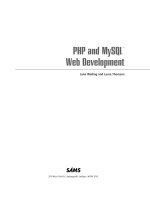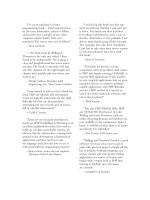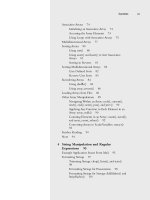PHP and MySQL Web Development - P3 docx
Bạn đang xem bản rút gọn của tài liệu. Xem và tải ngay bản đầy đủ của tài liệu tại đây (56.8 KB, 5 trang )
xi
Contents
Associative Arrays 74
Initializing an Associative Array 74
Accessing the Array Elements 74
Using Loops with Associative Arrays 75
Multidimensional Arrays 77
Sorting Arrays 80
Using sort() 80
Using asort() and ksort() to Sort Associative
Arrays 81
Sorting in Reverse 81
Sorting Multidimensional Arrays 82
User Defined Sorts 82
Reverse User Sorts 83
Reordering Arrays 84
Using shuffle() 84
Using array_reverse() 86
Loading Arrays from Files 86
Other Array Manipulations 89
Navigating Within an Array: each(), current(),
reset(), end(), next(), pos(), and prev() 90
Applying Any Function to Each Element in an
Array: array_walk() 90
Counting Elements in an Array: count(), sizeof(),
and array_count_values() 92
Converting Arrays to Scalar Variables: extract()
92
Further Reading 94
Next 94
4 String Manipulation and Regular
Expressions 95
Example Application: Smart Form Mail 95
Formatting Strings 97
Tr imming Strings: chop(), ltrim(), and trim()
98
Formatting Strings for Presentation 98
Formatting Strings for Storage: AddSlashes() and
StripSlashes() 101
00 525x fm 1/24/03 2:56 PM Page xi
xii
Contents
Joining and Splitting Strings with String Functions
103
Using explode(), implode(), and join() 103
Using strtok() 104
Using substr() 104
Comparing Strings 105
String Ordering: strcmp(),strcasecmp(), and str-
natcmp() 105
Testing String Length with strlen() 106
Matching and Replacing Substrings with String
Functions 106
Finding Strings in Strings: strstr(), strchr(), str-
rchr(), stristr() 107
Finding the Position of a Substring: strpos(), str-
rpos() 107
Replacing Substrings: str_replace(),
substr_replace() 108
Introduction to Regular Expressions 109
The Basics 110
Character Sets and Classes 110
Repetition 112
Subexpressions 112
Counted Subexpressions 112
Anchoring to the Beginning or End of a String
112
Branching 113
Matching Literal Special Characters 113
Summary of Special Characters 113
Putting It All Together for the Smart Form 114
Finding Substrings with Regular Expressions 115
Replacing Substrings with Regular Expressions 115
Splitting Strings with Regular Expressions 116
Comparison of String Functions and Regular
Expression Functions 116
Further Reading 116
Next 116
00 525x fm 1/24/03 2:56 PM Page xii
xiii
Contents
5 Reusing Code and Writing Functions 117
Why Reuse Code? 117
Cost 118
Reliability 118
Consistency 118
Using require() and include() 118
Using require() 119
File Name Extensions and require() 120
PHP Tags and require() 120
Using require() for Web Site Templates 120
Using auto_prepend_file and auto_append_file
125
Using include() 126
Using Functions in PHP 128
Calling Functions 128
Call to Undefined Function 130
Case and Function Names 130
Why Should You Define Your Own Functions? 131
Basic Function Structure 131
Naming Your Function 132
Parameters 133
Scope 135
Pass by Reference Versus Pass by Value 137
Returning from Functions 138
Returning Values from Functions 139
Code Blocks 140
Recursion 141
Further Reading 143
Next 143
6 Object-Oriented PHP 145
Object-Oriented Concepts 145
Classes and Objects 145
Polymorphism 147
Inheritance 147
Creating Classes,Attributes, Operations in PHP 147
Structure of a Class 148
Constructors 148
00 525x fm 1/24/03 2:56 PM Page xiii
xiv
Contents
Instantiation 149
Using Class Attributes 150
Calling Class Operations 151
Implementing Inheritance in PHP 152
Overriding 153
Multiple Inheritance 154
Designing Classes 155
Writing the Code for Your Class 156
Next 165
II Using MySQL
7 Designing Your Web Database 169
Relational Database Concepts 170
Tables 170
Columns 170
Rows 171
Values 171
Keys 171
Schemas 172
Relationships 172
How to Design Your Web Database 173
Think About the Real World Objects You Are
Modeling 173
Avoid Storing Redundant Data 173
Use Atomic Column Values 175
Choose Sensible Keys 176
Think About the Questions You Want to Ask the
Database 176
Avoid Designs with Many Empty Attributes
176
Summary of Table Types 177
Web Database Architecture 177
Architecture 178
Further Reading 179
Next 179
00 525x fm 1/24/03 2:56 PM Page xiv
xv
Contents
8 Creating Your Web Database 181
A Note on Using the MySQL Monitor 182
How to Log in to MySQL 183
Creating Databases and Users 184
Creating the Database 184
Users and Privileges 184
Introduction to MySQL’s Privilege System 185
Principle of Least Privilege 185
Setting Up Users:The GRANT Command
185
Types and Levels of Privilege 186
The REVOKE Command 188
Examples Using GRANT and REVOKE 189
Setting Up a User for the Web 190
Logging Out as root 190
Using the Right Database 190
Creating Database Tables 191
What the Other Keywords Mean 192
Understanding the Column Types 193
Looking at the Database with SHOW and
DESCRIBE 195
MySQL Identifiers 196
Column Data Types 197
Numeric Types 197
Further Reading 201
Next 202
9 Working with Your MySQL Database 203
What Is SQL? 203
Inserting Data into the Database 204
Retrieving Data from the Database 206
Retrieving Data with Specific Criteria 207
Retrieving Data from Multiple Tables 209
Retrieving Data in a Particular Order 214
Grouping and Aggregating Data 215
Choosing Which Rows to Return 217
Updating Records in the Database 217
00 525x fm 1/24/03 2:56 PM Page xv









